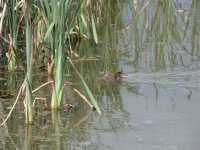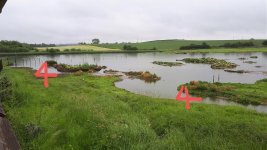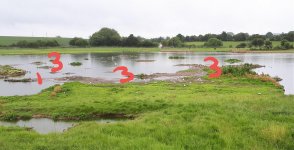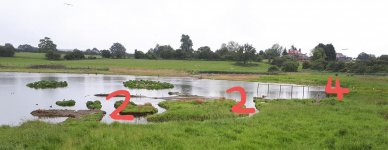-
Welcome to BirdForum, the internet's largest birding community with thousands of members from all over the world. The forums are dedicated to wild birds, birding, binoculars and equipment and all that goes with it.
Please register for an account to take part in the discussions in the forum, post your pictures in the gallery and more.
You are using an out of date browser. It may not display this or other websites correctly.
You should upgrade or use an alternative browser.
You should upgrade or use an alternative browser.
Upton Warren (10 Viewers)
- Thread starter andythomas
- Start date
More options
Who Replied?Phil Andrews
It's only Rock and Roller but I like it

Eclipse male Mandarin Duck at the Moors Pool as per Andy P
Last edited:
Phil Andrews
It's only Rock and Roller but I like it

A quick review of the stats reveals that this year has seen the most ever Avocet hatched with 49 emerged to date, surpassing the 41 hatched in 2013. That year also saw the highest number of birds successfully raised (32) which an overall fledgling rate of 75% for the reserve since Avocet first bred in 2003 (notably reduced from traditional levels by last year's disastrous breeding performance).
JTB - who has a far better handle on this than me - advises it's at least 52 young Avocet hatched this year to date, an even more impressive performance.
Where Bird
Well-known member
Reports
Phil A's comments about some birds being seen but not reported may well be correct.
On last Thursdays visit I stopped in the North Moor Hide briefly. The guy in there had seen a water rail in front of the hide. From our conversation I am sure he did. Phil W may know him they were in the West Hide at the same time earlier.
By way of nothing, I am pleased that Phil A confirmed my moth for me. However I must plead ignorance. The I.D. chart I bought did indeed call it a small magpie in the micro moth section. I left out the small in my post.
Looking up the moth in a book I then discovered there was a magpie moth as well different latin background alsol! So by missing off the small I appeared to identify it as the wrong moth!!
On that track - how many times have I had recently people telling me there are ringed plovers at the Flashes. There may well have been BUT when the birds were pointed out they were indeed LITTLE ringed plovers.
To close this the moth ID chart for whatever reasons only included the small magpie. The wall chart in the hide only seems to show the ringed plover. If you don't know the similar names the confusion is I hope, understandable
Phil E
Phil A's comments about some birds being seen but not reported may well be correct.
On last Thursdays visit I stopped in the North Moor Hide briefly. The guy in there had seen a water rail in front of the hide. From our conversation I am sure he did. Phil W may know him they were in the West Hide at the same time earlier.
By way of nothing, I am pleased that Phil A confirmed my moth for me. However I must plead ignorance. The I.D. chart I bought did indeed call it a small magpie in the micro moth section. I left out the small in my post.
Looking up the moth in a book I then discovered there was a magpie moth as well different latin background alsol! So by missing off the small I appeared to identify it as the wrong moth!!
On that track - how many times have I had recently people telling me there are ringed plovers at the Flashes. There may well have been BUT when the birds were pointed out they were indeed LITTLE ringed plovers.
To close this the moth ID chart for whatever reasons only included the small magpie. The wall chart in the hide only seems to show the ringed plover. If you don't know the similar names the confusion is I hope, understandable
Phil E
Last edited:
Where Bird
Well-known member
Notes for Sunday 16th
After noting the presence of an eclipse mandarin drake I felt obliged to have a look. It did nor oblige to be looked at. Oh well.
Of note on the Moors was the second set of common terns who were busy trying to take over a smaller raft. Whether they had already done so or were trying to get rid of a BHG I know not. No obvious signs of any nest of any kind.
The other two commons were firmly on their nest at the time.
The shoveler and the water rail on the N.Moors continue to elude me.
On the Flashes of note was a trio of very small avocet chicks which were quite happily paddling around in the area in front of the hide . The Delta?
Groups of avocets of varying ages were milling around and some of the adults were giving each other grief.
The caged LRP continues to sit patiently.
The prospective LRP nest on the right hand side seems to have fizzled out . The area seems completely empty were I saw the egg, and only one LRP seems to be standing guard from a distance as he appeared to be doing when there was an egg there
The 1st summer med was present -at last for me - and was giving grief vociferously to all other BHGs that got too close. Love the tongue! For the most part it was playing hide and seek in the vegetation on the ground stretching down from the hide. Worth getting wet on the way down, but on the way back the sun was shining,
Water level 0.46 0n the crooked gauge . Hen Brook much lower and calmer than I saw it last Friday. Considerably below the Hen Brook Hide bridge whereas on Friday it was touching the bottom of it and had obviously been over the top earlier.
After noting the presence of an eclipse mandarin drake I felt obliged to have a look. It did nor oblige to be looked at. Oh well.
Of note on the Moors was the second set of common terns who were busy trying to take over a smaller raft. Whether they had already done so or were trying to get rid of a BHG I know not. No obvious signs of any nest of any kind.
The other two commons were firmly on their nest at the time.
The shoveler and the water rail on the N.Moors continue to elude me.
On the Flashes of note was a trio of very small avocet chicks which were quite happily paddling around in the area in front of the hide . The Delta?
Groups of avocets of varying ages were milling around and some of the adults were giving each other grief.
The caged LRP continues to sit patiently.
The prospective LRP nest on the right hand side seems to have fizzled out . The area seems completely empty were I saw the egg, and only one LRP seems to be standing guard from a distance as he appeared to be doing when there was an egg there
The 1st summer med was present -at last for me - and was giving grief vociferously to all other BHGs that got too close. Love the tongue! For the most part it was playing hide and seek in the vegetation on the ground stretching down from the hide. Worth getting wet on the way down, but on the way back the sun was shining,
Water level 0.46 0n the crooked gauge . Hen Brook much lower and calmer than I saw it last Friday. Considerably below the Hen Brook Hide bridge whereas on Friday it was touching the bottom of it and had obviously been over the top earlier.
Phil Andrews
It's only Rock and Roller but I like it

Yesterday's WeBS counts courtesy of Dave J:
Canada Goose (64), Greylag Goose (3), Mute Swan (6), Shelduck (6), Shoveler (2), Gadwall (7), Mallard (101), Teal , Tufted Duck (68), Little Grebe (2), Great Crested Grebe (8), Grey Heron (3), Moorhen (7), Coot (37), Oystercatcher (6), Avocet (44), Lapwing (9), Black-headed Gull (940), Herring Gull , Lesser Black-backed Gull (5), Mediterranean Gull (1 - first summer at Moors Pool), Common Tern (7 - all at the Moors Pool)
Also noted yesterday were a juvenile Coal Tit at the Moors Pool, the Shoveler duckling still at the North Moors and the brood of 8 young Shoveler at the Flashes.
Canada Goose (64), Greylag Goose (3), Mute Swan (6), Shelduck (6), Shoveler (2), Gadwall (7), Mallard (101), Teal , Tufted Duck (68), Little Grebe (2), Great Crested Grebe (8), Grey Heron (3), Moorhen (7), Coot (37), Oystercatcher (6), Avocet (44), Lapwing (9), Black-headed Gull (940), Herring Gull , Lesser Black-backed Gull (5), Mediterranean Gull (1 - first summer at Moors Pool), Common Tern (7 - all at the Moors Pool)
Also noted yesterday were a juvenile Coal Tit at the Moors Pool, the Shoveler duckling still at the North Moors and the brood of 8 young Shoveler at the Flashes.
Last edited:
Where Bird
Well-known member
Bird numbers
Thanks to Dave J for doing the WeBS count - not something I would want to do or indeed could do. Thanks also to Phil A for posting it on here.
The difficulties of doing this are brought home when you realise the mobility of the birds. He notes the 1st summer med as being at the Moors. Couldn't find it there but on reaching the Flashes its beak stood out like a shining beacon in the sun. Yes sun! Then of course it went into hiding!
I gather you can't count unfledged birds in the count Fair enough.
Noted was a young coal tit and I wonder whether we should take more note in recording young birds. The GSW has brought its fledged offspring to the West Hide feeder last week. Not when I was there but shown the photo. Waching what I thought was the same male last week I note the first bird was flying off beyond the east Hide with its food, but this last bird, with or without its young, was heading into the trees by the West Hide side oft the Salwarpe path.
On all the feeders on the Moors there have been numerous young birds particularly blue tits , then great tits and the odd green finch reed bunting. On the N Moors a young robin.
Any young or old little birds in the trees I leave to others unless the sun is shining directly on them!
Yesterday's WeBS counts courtesy of Dave J:
Canada Goose (64), Greylag Goose (3), Mute Swan (6), Shelduck (6), Shoveler (2), Gadwall (7), Mallard (101), Teal , Tufted Duck (68), Little Grebe (2), Great Crested Grebe (8), Grey Heron (3), Moorhen (7), Coot (37), Oystercatcher (6), Avocet (44), Lapwing (9), Black-headed Gull (940), Herring Gull , Lesser Black-backed Gull (5), Mediterranean Gull (1 - first summer at Moors Pool), Common Tern (7 - all at the Moors Pool)
Also noted yesterday were a juvenile Coal Tit at the Moors Pool, the Shoveler duckling still at the North Moors and the brood of 8 young Shoveler at the Flashes.
Thanks to Dave J for doing the WeBS count - not something I would want to do or indeed could do. Thanks also to Phil A for posting it on here.
The difficulties of doing this are brought home when you realise the mobility of the birds. He notes the 1st summer med as being at the Moors. Couldn't find it there but on reaching the Flashes its beak stood out like a shining beacon in the sun. Yes sun! Then of course it went into hiding!
I gather you can't count unfledged birds in the count Fair enough.
Noted was a young coal tit and I wonder whether we should take more note in recording young birds. The GSW has brought its fledged offspring to the West Hide feeder last week. Not when I was there but shown the photo. Waching what I thought was the same male last week I note the first bird was flying off beyond the east Hide with its food, but this last bird, with or without its young, was heading into the trees by the West Hide side oft the Salwarpe path.
On all the feeders on the Moors there have been numerous young birds particularly blue tits , then great tits and the odd green finch reed bunting. On the N Moors a young robin.
Any young or old little birds in the trees I leave to others unless the sun is shining directly on them!
Phil Andrews
It's only Rock and Roller but I like it

Help! I've lost my Opticron telescope ES 80 GA. I was at Upton Warren yesterday. Please say it's been handed in.
Jackie
Not aware of anything but have put a request out on Twitter. Think Mike W might have been last down on Sunday; only aware of Janette visiting today. Any idea which hide Jackie?
Phil Andrews
It's only Rock and Roller but I like it

Ringed Black-headed Gulls 2A23 and 21L1 again both present at the Flashes on Saturday.
jackied
Jax
Not aware of anything but have put a request out on Twitter. Think Mike W might have been last down on Sunday; only aware of Janette visiting today. Any idea which hide Jackie?
No, def had it at the hen brook hide, then went on to the Moors. Lapwing hide and the new hide on the North Moors.
Phil Andrews
It's only Rock and Roller but I like it

Early morning at the Flashes JTB reporrs:
42 Avocet + 15 broods with 41 young, only 1 Lapwing (a sitting bird), Oystercatcher chick now fledged, 4 Little Ringed Plover, 4 Shelduck + 4 young
Cuckoo at the North Moors as per Andy A.
42 Avocet + 15 broods with 41 young, only 1 Lapwing (a sitting bird), Oystercatcher chick now fledged, 4 Little Ringed Plover, 4 Shelduck + 4 young
Cuckoo at the North Moors as per Andy A.
Last edited:
Birder Gladys
Well-known member
Help! I've lost my Opticron telescope ES 80 GA. I was at Upton Warren yesterday. Please say it's been handed in.
Jackie
Hi Jackie
I only went to the moors east hide Sunday teatime didn't notice anything in there sorry only other car in car park was a small red Toyota hatchback but I didn't see anyone in the hides opposite. Tim
upstarts1979
Well-known member
No, def had it at the hen brook hide, then went on to the Moors. Lapwing hide and the new hide on the North Moors.
Can you ring me John Belsey
I hsve sent you a private message:t:
upstarts1979
Well-known member
Today at FLASHES breeding survey
An early start 5.30am, I intended to move over to the Moors at some stage but spent the whole 13 hours at the FLASHES.
I don't expect any real migration at this time of year and to be fair I enjoy plotting where the Avocet nest, feed and how many chicks survive. All this data has helped us work out where the best nesting sites are but more importantly where the most productive feeding areas are. It is also important that the water level is at the optimum level to maximise the number of these chick rearing zones.
This information was passed on to the WWT and they improved the areas to mitigate the lower water levels required to improve the salt plant cover.
The small amount of migrants included:- Curlew, Med Gull , teal, swallow, sand martin, cormorant .
Breeding Birds:-
Shoveler 4 ads all fems +8:5ch
Shelduck 6ads + 4 ch
Mallard at least 9 broods
Canada geese 5 broods
Avocet 15 broods 42 chicks.
From the west side of gulley/ meadow clockwise
1:3:3:3:4:2:4:2:2:4:4:3:3:1:3
Lapwing the ladt breeding hatched 1 chick this morning and still incubating eggs.
Oystercatcher 2ads+1 fully fledged chick
Coot at least 3 broods.
BHG at least a 1000-1100 chick/juvs
Species Count Flashes:-
Gadwall 4. Teal male, Mute swan 2. Tufted c30. Grey heron, cormorant diving in 1st Flash.
Lapwing 5. LRP 5. Curlew.
Med Gull 2nd summer new bird, 1st Summer
Herring gull 2. LBBG 5.
Peregrine. Buzzard 2.
Stock dove 30, collared dove 2 unusual at Flashes. Feral pigeon.
Swift c25. Rook c35. Jay.
Swallow 3. Sand martin 3. House Martin 30+
Skylark 2 singing. Starling 2. Song thrush 3.
Pied wag 1.
Lesser Whitethroat. Whitethroat pair taking food on north side of hen brook. Blackcap 5. Chiffchaff 2 singing.
Reed warbler 5+ most along east side of 3rd Flash.
Cetti's w 2 singing along hen brook,
Linnet 5 (1 singing), goldfinch 6.
Large tit flock c80 including juv and adult Coal tit. 30+ long tailed tit.
Sailing pool:-
GCG 4 +2 chicks. Greylag 3 broods 2:6:1 , tufted 12.
An early start 5.30am, I intended to move over to the Moors at some stage but spent the whole 13 hours at the FLASHES.
I don't expect any real migration at this time of year and to be fair I enjoy plotting where the Avocet nest, feed and how many chicks survive. All this data has helped us work out where the best nesting sites are but more importantly where the most productive feeding areas are. It is also important that the water level is at the optimum level to maximise the number of these chick rearing zones.
This information was passed on to the WWT and they improved the areas to mitigate the lower water levels required to improve the salt plant cover.
The small amount of migrants included:- Curlew, Med Gull , teal, swallow, sand martin, cormorant .
Breeding Birds:-
Shoveler 4 ads all fems +8:5ch
Shelduck 6ads + 4 ch
Mallard at least 9 broods
Canada geese 5 broods
Avocet 15 broods 42 chicks.
From the west side of gulley/ meadow clockwise
1:3:3:3:4:2:4:2:2:4:4:3:3:1:3
Lapwing the ladt breeding hatched 1 chick this morning and still incubating eggs.
Oystercatcher 2ads+1 fully fledged chick
Coot at least 3 broods.
BHG at least a 1000-1100 chick/juvs
Species Count Flashes:-
Gadwall 4. Teal male, Mute swan 2. Tufted c30. Grey heron, cormorant diving in 1st Flash.
Lapwing 5. LRP 5. Curlew.
Med Gull 2nd summer new bird, 1st Summer
Herring gull 2. LBBG 5.
Peregrine. Buzzard 2.
Stock dove 30, collared dove 2 unusual at Flashes. Feral pigeon.
Swift c25. Rook c35. Jay.
Swallow 3. Sand martin 3. House Martin 30+
Skylark 2 singing. Starling 2. Song thrush 3.
Pied wag 1.
Lesser Whitethroat. Whitethroat pair taking food on north side of hen brook. Blackcap 5. Chiffchaff 2 singing.
Reed warbler 5+ most along east side of 3rd Flash.
Cetti's w 2 singing along hen brook,
Linnet 5 (1 singing), goldfinch 6.
Large tit flock c80 including juv and adult Coal tit. 30+ long tailed tit.
Sailing pool:-
GCG 4 +2 chicks. Greylag 3 broods 2:6:1 , tufted 12.
Last edited:
Phil Andrews
It's only Rock and Roller but I like it

First report of a third brood of Greylag Geese on the Sailing Pool - how old was the gosling compared to the other two broods John?
upstarts1979
Well-known member
First report of a third brood of Greylag Geese on the Sailing Pool - how old was the gosling compared to the other two broods John?
No more than a week:t:
Phil Andrews
It's only Rock and Roller but I like it

Phil Andrews
It's only Rock and Roller but I like it

Red Kite circled over the A38 east of the Moors Pool this afternoon as per Phil W.
Phil Andrews
It's only Rock and Roller but I like it

2 pairs of Common Tern sitting at the Moors Pool this fternoon as per Phil W.
Ringed gull heaven in the Flashes roost this evening as per Mike W - regular Black-headed Gulls 2K44, 21L1 and 26V7 plus a new bird - black ring with white code 2CAT - ringed at Marsh Lane NR. Also a German-ringed first summer Med Gull - yellow ring with black code APGS - plus another unringed first summer bird.
There was a different yellow ringed Med Gull (second summer) noted on the 27th March; unfortunately the code couldn't be read.
Ringed gull heaven in the Flashes roost this evening as per Mike W - regular Black-headed Gulls 2K44, 21L1 and 26V7 plus a new bird - black ring with white code 2CAT - ringed at Marsh Lane NR. Also a German-ringed first summer Med Gull - yellow ring with black code APGS - plus another unringed first summer bird.
There was a different yellow ringed Med Gull (second summer) noted on the 27th March; unfortunately the code couldn't be read.
Last edited:
Similar threads
- Replies
- 1
- Views
- 1K








